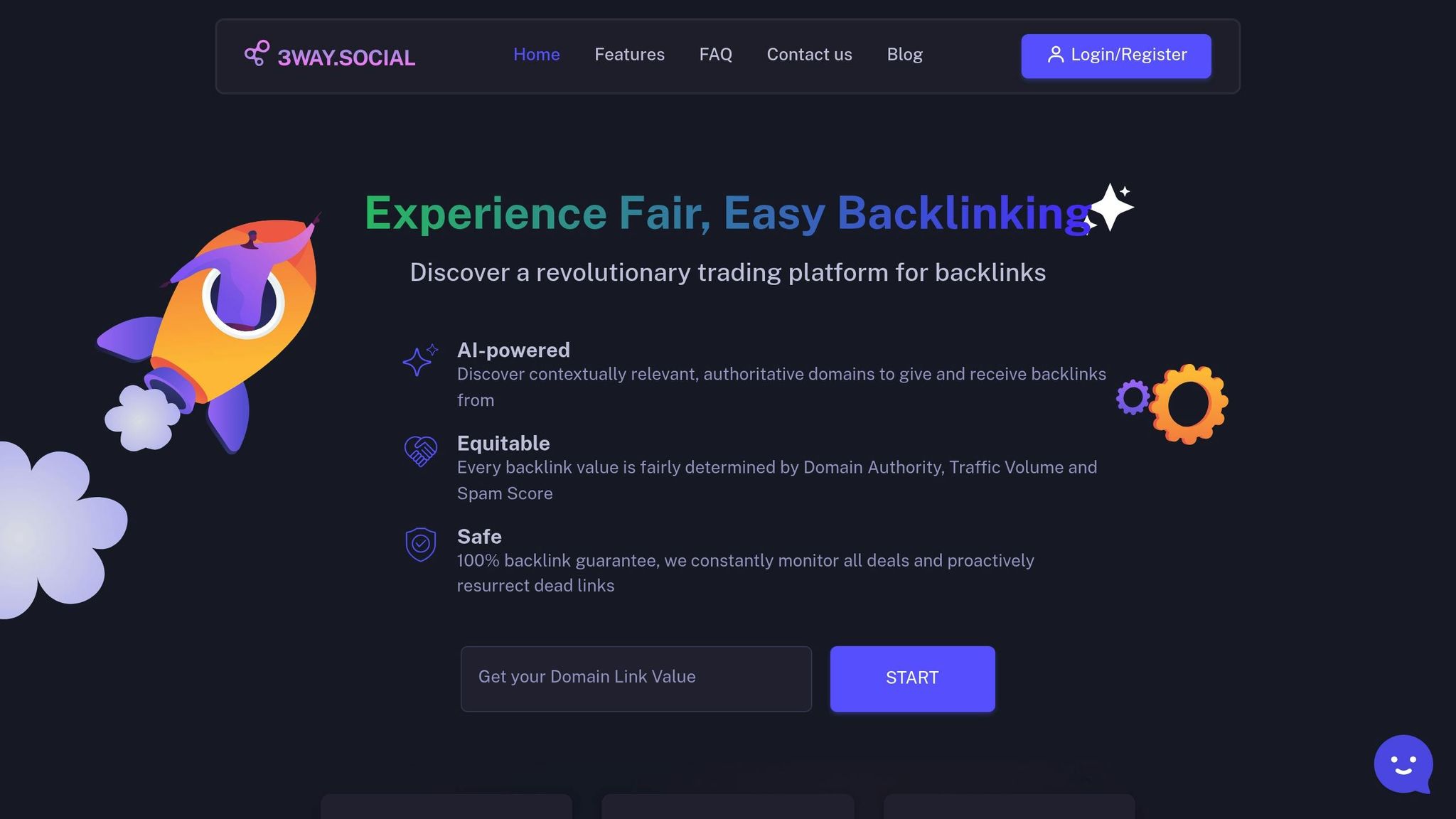Last Updated on June 18, 2025 by Becky Halls
Backlinks are a key factor in SEO success, but bad practices can hurt your rankings or even get you penalized. This guide explains how to build backlinks the right way – safely and effectively.
Key Takeaways:
- Why backlinks matter: Pages with more high-quality backlinks rank higher and get more traffic (53% of website traffic comes from organic search).
- Risks of bad links: Spammy or manipulative links can lead to penalties or even de-indexation from Google.
- Safe strategies: Focus on methods like direct outreach, guest posting, and using niche directories.
- Content is key: Great content attracts natural backlinks – think guides, original research, and infographics.
- Tools to use: Platforms like Ahrefs, Semrush, and 3Way.Social help monitor and improve your backlink profile.
Start by creating valuable content, building real relationships, and avoiding risky tactics. Ready to dive deeper? Keep reading for actionable tips and tools to boost your SEO without breaking the rules.
3 SEO Backlink Strategies: DOs & DON’Ts
Getting Ready for Link Building
Before you start reaching out to websites or launching outreach campaigns, it’s essential to lay a solid foundation. The most effective link-building strategies begin with creating content that naturally attracts links and a deep understanding of your audience.
Making Content That Earns Links
To attract links, you need to create standout "linkable assets" – content that offers exceptional value. With 94% of online content earning no links, yours must rise above the noise.
Focus on producing ultimate guides that tackle popular yet underserved topics. These guides should address your audience’s needs comprehensively. Another great approach is original research or data compilation. Surveys, industry trend analyses, or curated statistics can draw backlinks from bloggers and publishers looking for credible sources. For example, lists of statistics on niche topics often become go-to resources for content creators seeking supporting data.
Experiment with different content formats to generate links. Lists, "why" posts that explain trends, "what" posts that define concepts, and videos that simplify complex ideas are all highly shareable. Among these, list posts are especially effective – they’re consistently one of the most shared types of content.
Visual content is another powerful tool. High-quality images, infographics, and custom graphics can attract backlinks when offered for free use with proper credit. For example, infographics based on data or step-by-step breakdowns of complex topics are highly linkable. Custom visuals tailored to topics frequently covered by bloggers can also drive links.
Additionally, creating unique strategies or techniques with memorable names can encourage others to link back to your content when referencing your method. As Derek Halpern puts it:
"You may not have unique ingredients, but you’ve got a unique recipe. And that unique recipe is all that matters".
Developing your own approaches to common problems and branding them with distinctive names can make your content more shareable. For instance, one company created a keyword research tool that generated backlinks at a cost of just 19.4 cents per link.
Once you’ve created compelling content, the next step is to ensure it resonates with the right audience.
Finding Your Target Audience
Understanding your audience goes beyond basic demographics. Knowing what motivates them ensures you build backlinks that align with search guidelines. Your link-building audience includes website editors, webmasters, marketing managers, and even search engine crawlers.
Start with demographic analysis to uncover basic details like age, gender, location, education, and job roles. Then, dive deeper with psychographic analysis to understand their interests, values, lifestyles, and opinions. Combining these insights helps you identify who your audience is and what drives their behavior.
Consider this: 68% of consumers expect personalized experiences, yet only 42% of marketers know their audience’s demographics, and fewer than half understand their interests and hobbies. This gap highlights the importance of truly knowing your audience.
To identify the right linking opportunities, analyze the content and social profiles of potential websites. Join industry forums and social media groups where your audience is active, and pay attention to the challenges, interests, and questions they discuss. Use analytics tools to track what content resonates most with your audience and when they engage.
Develop detailed buyer personas for your ideal linking partners. These should include their content preferences, publishing habits, audience demographics, and the types of sources they typically reference. You can also analyze your competitors’ strategies by reviewing their marketing materials, social campaigns, and the sites that link to them. This research can help you discover untapped opportunities and reach audiences that others may overlook.
For example, during the 2008 financial crisis, McDonald’s adjusted its marketing by emphasizing affordable options, addressing its audience’s need for value, and using the channels their customers frequented.
To succeed in link building, you need to understand what a target site’s audience finds interesting or useful. By aligning your content with their needs and building genuine relationships through personalized outreach, you’ll set the stage for link-building success.
Safe Link-Building Methods That Work
Once you’ve created engaging content and have a solid grasp of your audience, it’s time to dive into effective link-building strategies. These approaches focus on forming meaningful connections and offering genuine value instead of trying to game search engine rankings.
Direct Outreach for Quality Links
Direct outreach is all about reaching out to website owners or content creators with tailored messages. These messages should highlight specific content on their site and explain why adding your resource would be beneficial. The more personalized your outreach, the better your chances of success.
The secret? Offer clear value. As Mara Calvello explains:
"Websites are given visibility due to reputational networks, and backlinks are a quick and effective way to earn visibility for your site".
When reaching out, be concise and straightforward. Clearly state your request, suggest where your link might fit, and provide anchor text recommendations. Another smart move is to monitor unlinked mentions of your brand – times when your business is mentioned but not linked – and politely ask for a link. To sweeten the deal, you could offer something in return, like linking to their content or sharing their article on social media. Keep follow-ups limited; one polite reminder is usually enough to avoid appearing spammy.
You can also expand your efforts by exploring content partnerships, such as guest posting, to diversify your link sources.
Guest Posting on Quality Sites
Guest posting is an excellent complement to direct outreach, offering another route to secure high-quality backlinks. Focus on reputable blogs or websites within your niche that have strong domain authority and a loyal audience.
Start with research. Use search operators like "[topic keyword phrase] + 'write for us'" to find sites open to guest posts. You can also analyze competitor backlinks using tools like Semrush or Ahrefs. Before pitching, ensure the site aligns with your audience and marketing goals.
Building rapport with site owners is crucial. Engage with their content – leave thoughtful comments or share their posts – before sending your pitch. When you’re ready to pitch, personalize your message and show that you understand their audience, writing style, and content preferences. As Copy.ai notes:
"Effective pitching starts with an in-depth understanding of the target site’s audience, content scope, tone, and submission preferences".
Be clear about the value your post will bring, offering actionable insights or unique perspectives. Keep your pitch brief, highlighting the proposed title and its benefits. Avoid generic templates; tailor your pitch to resonate with the site’s readers.
Using Industry Directories
Industry directories can be a reliable way to build credible backlinks, provided you choose them wisely. Focus on directories that are specific to your niche and have a strong editorial review process to maintain quality. Look for directories that offer dofollow links to maximize SEO benefits.
Aaron Whittaker from Thrive emphasizes this point:
"The key is hyper-relevance – we completely skip general directories and focus only on authoritative industry-specific ones".
Paul DeMott from Helium SEO adds:
"Links from credible, industry-specific directories are valuable because they add context. Search engines assess these links to understand your business’s relevance in a particular niche or geography".
Before committing to a directory, confirm its quality and whether it’s indexed by search engines. Optimize your listing with relevant keywords, a complete profile, and high-quality visuals. Avoid directories without a proper vetting process, and keep your listing updated to ensure its continued value. It’s worth noting that 84.6% of SEOs and link builders prioritize relevance when assessing links.
Building Relationships for Natural Links
The best long-term strategy for link building is cultivating genuine relationships instead of focusing solely on transactional link exchanges. Treat outreach as an opportunity to build lasting connections rather than just a way to secure a backlink. As Vlad Orlov from Respona highlights:
"Ethical link building means building links without crossing Google’s guidelines, and, of course, not spamming people".
Stay active in your industry by engaging on social media, forums, and professional networks. Offer value first – share helpful resources, provide expertise, or facilitate introductions – before making any requests. Attending industry events, whether online or in person, is another great way to form authentic connections. Over time, these relationships naturally lead to backlinks, enhancing your site’s credibility in a sustainable way.
sbb-itb-88880ed
Creating a Balanced Backlink Profile
After diving into safe link-building methods, the next step is to bring these strategies together into a well-rounded, natural backlink profile. Building a strong backlink profile isn’t about amassing links – it’s about creating a diverse, trustworthy mix that search engines recognize as credible. A balanced profile boosts your site’s authority and helps safeguard it from algorithm updates.
Think of a backlink profile as your website’s trust report. Considering that 95% of pages analyzed have no backlinks at all, having a strong profile immediately sets you apart. But the real trick is understanding what makes a profile effective rather than risky.
Best Types of Backlinks to Build
A strong backlink profile thrives on variety and quality. Studies show that the number of unique domains linking to a page is one of the strongest factors for higher rankings. However, not all backlinks are created equal.
- Editorial links: These are premium backlinks that happen naturally when journalists, bloggers, or content creators reference your content because it genuinely adds value. Since these links are earned, they carry substantial weight.
- Contextual links: Links embedded within relevant content are particularly powerful. When your link appears in a paragraph discussing a topic directly tied to your business, search engines view it as highly relevant.
- Resource page links: Many websites curate lists of useful resources for specific industries. Being featured on these pages signals your content is recognized as valuable within your niche.
- High-quality directory links: Links from niche-specific directories with strong domain authority and editorial oversight can strengthen your profile. Avoid general or low-quality directories.
Anchor text diversity is also critical. Using a mix of exact matches, partial matches, branded terms, generic phrases, and plain URLs prevents over-optimization penalties while signaling authenticity to search engines.
Visual content is another game-changer. Research shows that visual content generates 650% more engagement than text alone. Infographics and other visual assets are particularly effective in attracting backlinks from a wide range of websites.
By focusing on these diverse backlink types, you can build a strong foundation. But protecting this profile means steering clear of harmful practices.
Spotting and Avoiding Bad Link Practices
Protecting your backlink profile from harmful practices is as important as building it. Toxic backlinks can harm your rankings and damage your site’s reputation. These often come from low-quality, spammy, or malicious websites.
- Avoid link schemes: Practices like private blog networks (PBNs) and paid links violate Google’s guidelines and can lead to penalties.
- Be cautious with directories: Steer clear of directories that accept any site without review, charge excessive fees, or exist solely to provide backlinks.
- Watch for spammy websites: Red flags include excessive ads, suspicious domain names, poor user experience, and content written for search engines rather than people.
As Greg Heilers and Morgan Taylor from Jolly SEO explain:
"Bad backlinks are a problem not just because they can lead to penalties by Google. Backlinks with a negative traffic trajectory also provide a decreasing ROI as they age".
They also highlight that most backlinks won’t actively harm your SEO:
"Most backlinks, even in a worst-case scenario, will not cause negative SEO, but rather will just be ignored by Google. In cases where a backlink is especially spammy, such as a bad traffic trend, or has outbound anchor texts like ‘casino’ AND it is completely irrelevant to your business, then taking action is recommended".
Regular audits using tools like Google Search Console help maintain quality. If harmful links are found, reach out to site owners for removal or, as a last resort, use Google’s disavow tool. Keeping your profile clean ensures it remains strong and credible.
Using 3Way.Social for Smart Link Building

To simplify the process of building a diverse backlink profile, platforms like 3Way.Social offer a structured, ethical approach. Their AI-powered domain matching connects you with high-quality sites relevant to your niche, eliminating much of the guesswork in link building.
One major challenge in link building is ensuring fair value exchange. 3Way.Social solves this with algorithms that evaluate domain authority, relevance, and other factors to create balanced partnerships.
- Permanent do-follow links: These links provide lasting SEO value without the risk of disappearing over time, ensuring consistent rankings.
- Advanced link diversification: The platform helps you secure links across various content types, industries, and contexts, creating the variety search engines favor.
- Guest posting opportunities: Earn editorial-style links by contributing expert content to reputable sites, building both authority and backlinks.
A balanced backlink profile often includes a mix of followed and no-followed links. Aim for a ratio of 80% to 20% or 70% to 30% in favor of followed links. 3Way.Social’s dashboard makes it easy to track these ratios, helping you maintain a natural, search-engine-friendly profile.
Tools for Managing Backlink Quality
Building and maintaining a strong backlink profile is no small task. As Greg Heilers and Morgan Taylor from Jolly SEO explain:
"Link building isn’t ‘set it and forget it.’ You need to constantly monitor your backlink profile so you don’t lose any valuable links and timely weed out bad ones."
To protect your site from penalties and maintain a healthy link profile, ongoing monitoring is critical. With 85% of marketers agreeing that link building is key to boosting their brand’s visibility, having the right tools in place makes all the difference for long-term SEO success.
Best Tools for Backlink Analysis
A strong backlink profile starts with the right tools. These platforms provide insights and data to help you stay ahead of potential issues and make informed decisions. Here’s a breakdown of some of the top tools:
- Ahrefs: Known for its frequent updates (every 15 to 30 minutes) and comprehensive analysis features, Ahrefs is a favorite among SEO professionals. It helps track new backlinks, monitor lost ones, and analyze competitors. Plans start at $29/month. Notably, 69% of SEOs trust Ahrefs’ Domain Rating (DR) as the most reliable authority score.
- Semrush: Offering more than just backlink analysis, Semrush is an all-in-one SEO toolkit. Its database includes over 43 trillion backlinks, and its Backlink Audit tool is great for identifying harmful links. Plans start at $139.95/month.
- SE Ranking: For those on a tighter budget, SE Ranking provides solid features at $52/month, with access to a database of 2.9 trillion links.
- Seobility: Another affordable option, Seobility offers a premium plan for $50/month, making it a practical choice for consistent backlink tracking.
- Majestic: Specializing in historical backlink data, Majestic provides insights into long-term trends with its 21 trillion-link database. Plans start at $49/month.
- 3Way.Social: This tool uses AI to match you with high-quality domains, simplifying link-building efforts. Its dashboard also helps you maintain balanced link ratios that search engines favor.
How to Check Domains and Link Context
Evaluating the quality of domains and link contexts goes beyond basic metrics. While domain authority and page authority scores provide a starting point, deeper analysis is necessary to understand a link’s true value.
- Relevance Matters: Ensure the linking site aligns with your industry or niche. Links from unrelated topics carry less weight than those from relevant publications.
- Context Counts: Links should appear naturally within relevant content, not in spammy sections or link farms.
- Audience Overlap: Use tools like Ahrefs or Semrush to verify that the linking site’s audience aligns with your target demographic.
- Trust Signals: Look for established authority, high-quality content, secure domains, and a positive reputation. Avoid sites with excessive ads, suspicious names, or content written solely for SEO purposes.
- Anchor Text: The linking text should be relevant and naturally integrated into the content. A diverse anchor text profile helps avoid penalties for over-optimization.
Regular checks – weekly or monthly – are crucial for catching issues early. By staying proactive, you can prevent problems before they affect your rankings.
Backlink Types Comparison
Different types of backlinks offer unique advantages and challenges. Understanding these can help you craft a more strategic approach to link acquisition.
| Backlink Type | Pros | Cons | Best Use Cases |
|---|---|---|---|
| Guest Posting | High relevance, editorial control, relationship building | Time-consuming; requires quality content creation | Establishing authority and targeting specific audiences |
| Directory Links | Easy to secure, quick implementation | Limited SEO impact; risk of low-quality links | Local SEO and niche directories |
| Manual Outreach | Builds genuine relationships, quality placements | Labor-intensive; low response rates | Long-term partnerships with high-value sites |
| Resource Pages | Strong editorial validation, lasting value | Competitive placement, limited opportunities | Promoting tools, guides, or industry resources |
| Editorial Links | High authority, natural placement, trusted by search engines | Difficult to control; requires standout content | News, research, or unique insights |
Guest posting is a standout strategy for securing high-quality backlinks. It gives you control over content quality and placement while fostering relationships with site owners. Directory links, though less impactful individually, are useful for local SEO and niche industries, adding diversity to your link profile. Manual outreach, while effort-intensive, can yield valuable placements on high-authority sites.
To maximize results, blend multiple approaches tailored to your industry and goals. Tools like Ahrefs and Semrush can track which backlink types perform best, while platforms like 3Way.Social streamline the process by identifying promising opportunities. This mix of strategies ensures a steady flow of quality backlinks, keeping your SEO efforts both effective and ethical.
Building Quality Backlinks the Right Way
Earning quality backlinks is all about creating value and fostering genuine connections – it’s not about shortcuts or tricks. The strategies in this guide focus on methods that search engines reward, leading to better rankings, more traffic, and long-term SEO success.
Here’s how to approach backlink building with integrity and purpose.
Main Points from This Guide
Start with great content.
To attract backlinks naturally, you need to create content worth linking to. Think of assets like benchmark reports packed with fresh data.
Build real relationships.
Quality links come from meaningful connections, not quick fixes. Prioritize authentic relationships over short-term gains.
Focus on quality over quantity.
One strong backlink can outweigh dozens of weak ones. Plus, it shields your site from penalties tied to manipulative practices. As Josh Brown puts it:
"Ethical link building helps create a solid foundation for your website that helps minimize the risks of getting your site hit with a penalty or seeing a massive drop in rankings when search engines like Google make algorithmic changes".
Diversify your link sources.
Mix up your strategies with guest posts, directory listings, and editorial mentions. This variety helps create a natural backlink profile that search engines trust.
Keep an eye on your backlinks.
Use tools to regularly audit your backlink profile. Catching issues early can save your rankings from taking a hit.
These principles lay the groundwork for a safe and effective link-building strategy.
Your Next Steps for Safe Link Building
Pick one strategy to start with and execute it well. Guest posting is often a great choice – it gives you control over content quality and helps you build valuable industry connections. Erika Jörg from Intero Digital explains:
"Guest posting is a fantastic way to grow your website. It drives organic traffic, boosts your site’s credibility with valuable backlinks, and helps you reach a wider audience. Plus, it opens up great networking opportunities with industry influencers. 100% recommended!".
Within the next 30 days, aim to create a linkable asset, like an industry report or an in-depth guide, that delivers clear value.
To streamline your efforts, consider tools like 3Way.Social. Its AI-driven matching system connects you with high-quality domains while maintaining natural link patterns. Users report an average 20% increase in traffic and faster ranking improvements – up to three times quicker.
Melih Ozlatay from Smartfinds Internet Marketing emphasizes the importance of ethical practices:
"We find that sticking to ethical link-building is the best way to succeed. With important clients, there’s no room for black hat tactics. We always suggest a steady and reliable approach, using guest blogging, press releases, and getting our clients mentioned by journalists, reporters, and influencers. It’s better to move slowly but surely".
The secret to quality backlinks isn’t in taking shortcuts – it’s about creating content worth linking to and building connections with people who recognize its value. Stick to these principles, and you’ll not only see sustainable SEO results but also avoid penalties that come with shady tactics.
FAQs
What is the difference between ethical and risky link-building strategies?
Ethical link-building strategies stick to search engine guidelines and emphasize quality and relevance. This means focusing on activities like guest posting on reputable sites, reaching out to well-regarded websites in your niche, and leveraging trusted industry directories. These approaches not only boost your site’s authority but also build credibility that lasts, all while steering clear of penalties.
On the flip side, risky tactics involve shortcuts like buying links, joining link schemes, or relying on spammy and irrelevant links. While these might offer quick results, they can lead to search engine penalties and harm your rankings in the long run. The core difference? Ethical strategies are about building genuine, sustainable connections, while risky ones gamble on methods that often backfire.
How can I spot and avoid harmful backlinks that could hurt my site’s SEO?
To keep your site’s SEO in good shape, make it a habit to check your backlink profile with tools like SEMrush or Ahrefs. Pay attention to links coming from low-quality, irrelevant, or spammy websites – these can drag down your rankings. Steer clear of backlinks from sites that have poor content, minimal traffic, or unnatural link-building patterns.
If you come across harmful links, you can use a disavow tool to signal search engines to ignore them. Instead, channel your efforts into earning high-quality backlinks from trusted sources, such as respected industry directories, educational sites, or reputable blogs. Regularly monitoring and managing your backlinks will help protect your site’s SEO and ensure you stay aligned with search engine rules.
What are the best ways to create content that naturally earns high-quality backlinks?
To attract high-quality backlinks naturally, focus on producing content that people find valuable and want to share. Think along the lines of detailed guides, original research, or data-driven reports. These types of resources are often cited as trusted references, making them prime candidates for earning backlinks.
You can also experiment with engaging formats like infographics, videos, or interactive tools. These are not only visually appealing but also easy to share, increasing their reach. By tailoring your content to your specific niche and addressing the unique needs of your audience, you boost its relevance and the chances of it being linked to. Above all, aim for quality and genuine value to make your content stand out while staying aligned with search engine best practices.



